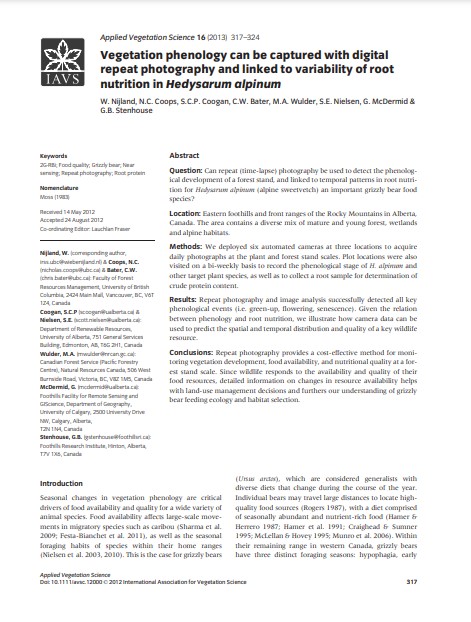Vegetation phenology can be captured with digital repeat photography and linked to variability of root nutrition in Hedysarum alpinum
Bosque Modelo:
Foothills
Temática:
Conservación
Tipo de documento:
Artículo científico
Resumen
Question: Can repeat (time-lapse) photography be used to detect the phenological development of a forest stand, and linked to temporal patterns in root nutrition for Hedysarum alpinum (alpine sweetvetch) an important grizzly bear food species?
Location: Eastern foothills and front ranges of the Rocky Mountains in Alberta, Canada. The area contains a diverse mix of mature and young forest, wetlands and alpine habitats.
Methods: We deployed six automated cameras at three locations to acquire daily photographs at the plant and forest stand scales. Plot locations were also visited on a bi-weekly basis to record the phenological stage of H. alpinum and other target plant species, as well as to collect a root sample for determination of crude protein content.
Results: Repeat photography and image analysis successfully detected all key phenological events (i.e. green-up, flowering, senescence). Given the relation between phenology and root nutrition, we illustrate how camera data can be used to predict the spatial and temporal distribution and quality of a key wildlife resource.
Conclusions: Repeat photography provides a cost-effective method for monitoring vegetation development, food availability, and nutritional quality at a forest stand scale. Since wildlife responds to the availability and quality of their food resources, detailed information on changes in resource availability helps with land-use management decisions and furthers our understanding of grizzly
bear feeding ecology and habitat selection.
Información Bibliográfica
Autor:
Nijland, W., Coops, N.C., Coogan, S.C.P., Bater, C.W., Wulder, M.A., Nielsen, S.E., Mcdermid, G., & Stenhouse, G.B.
Revista:
Applied Vegetation Science
Año:
2013
N°:
-
País :
Canadá
Páginas:
317 - 324
Volumen:
16
Idioma:
Ingles
Palabras claves
2G-RBi; Food quality; Grizzly bear; Near sensing; Repeat photography; Root protein





